Why brush your dog?
It doesn’t matter the type of coat your dog has – long or short, thick or thin, non-shedding or low shedding or double coated (ie breeds that shed their undercoat). Regularly brushing your dog is crucial not only for appearance and vanity but for your dog’s overall health and hygiene.
The key here is regularly. It is better to brush your dog every day or every few days depending on the breed and coat type. This is better than a big session once in a while. Over-brushing your dog can cause brush burn to their skin and damage the coat if down in one big session
Here are more reasons to brush your dog.
- Removes excess fur. Significantly reduces the amount of fur you have to deal with on your furniture, car or clothing. Who wants to do more housework than necessary?
- Brushing removes dirt and any items such as leaves and twigs caught up in their coat. This keeps them cleaner and smelling nicer longer between bathing.
- It helps distribute the natural oils in your dog’s skin and coat. This keeps their coat healthy, shiny and looking it’s best.
- It is a great way to monitor your dog’s health. You may discover any lumps and warts, fleas and ticks, cuts, grass seeds, skin irritations and anything that looks unusual.
- Removes tangles and matts which can be uncomfortable for your dog. These may cause broken blood vessels, skin infections and may cause sores to form.
- Brushing aerates and hydrates your dog’s skin and fur and stimulates circulation. This enables their coat to perform its natural function of regulating body temperature.
- Promotes bonding between you and your dog and builds trust. Helps your dog get used to be touched in various places and being handled without feeling anxious about it.
- If you want to keep your dog’s coat longer it avoids disappointment when being told by the groomer that it needs to be clipped off as it has become too matted.
What is the best brush for my dog?
Selecting the best tools for the job and using the most effective techniques will make the brushing process more comfortable for your dog and be more efficient for getting the job done. It is easy to become discouraged and lose motivation if you don’t seem to be making progress.
It is not really a case of which brush is best for your dog’s particular coat, but a combination of different tools. I mainly use three grooming tools for most dogs. They are a slicker brush, a 9 tooth de-matting comb and a 50/50 steel comb.
Slicker Brush
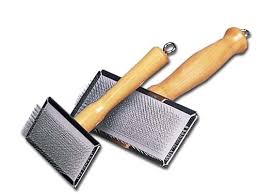
The slicker brush is a pin brush which is used mainly as a dressing brush. This puts a shine on the coat and works well to loosen tangles and break the coat up to allow the other tools to finish the job.
9 Tooth Dematting Comb
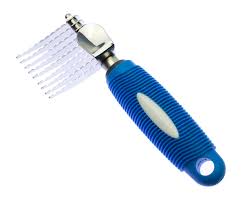
The 9 tooth de-matting comb is used to splice matts and tangles in the coat. There are various de-matting tools available but this is my preferred tool. It works well for removing knots and tangles and also works well to remove bulk undercoat in double coated dogs.
The trick is not to rip the matt out with this tool but to roll your wrist when you meet resistance and gently splice through the knot.
50/50 Steel Comb
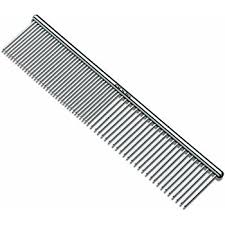
A good comb is an essential tool for anyone who grooms a dog. Once you have gone over the area with the slicker brush first, ran the de-matting comb through to remove any tangles you can comb through again, first with the wider teeth and then again with the finer teeth. If you can’t run the finer teeth of the comb through the coat without resistance the coat is not fully brushed out. Repeat the process until you can.
There are other types of steel comb available including some with a handle which some people find more comfortable to hold.
Best tools for de-shedding dogs with undercoat.
You can’t stop shedding altogether, but ensuring your dog is healthy and with regular brushing and bathing it can be reduced significantly. Read “How to reduce shedding” to learn more
The main thing you can do to reduce shedding is regularly brushing your dog. Brushing helps to remove excess and loose fur and redistributes your dog’s skin oil into the fur helping it to stay in place.
The best brush to use for your dog will depend on the type of coat they have. For short-haired smooth coat breeds such as pointers and dalmatians, a bristle brush similar to the one you may use on your own hair. Alternatively a rubber grooming tool such as a Zoom Groom or similar.
For many breeds from shepherds, spaniels or other medium to long coat breeds a slicker brush. These brushes have tiny tightly packed short wire pins. These are good to loosen undercoat and to remove any tangles before using a de-shedding tool.
There are a few different types of de-shedding tools such as Furninators, shedding blades and undercoat rakes. Be very careful when brushing your dog not to press too hard or do too much at once as you can cause brush burn on your dog’s skin.
A good stainless steel 50/50 comb or de-matting comb is ideal to run through your dog’s coat after brushing to get any remaining dead undercoat the brush may not have picked up.
The Furminator
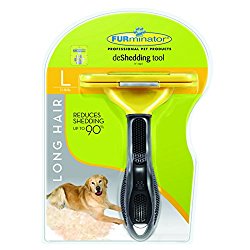
The Furminator is a very popular tool for de-shedding double coated dogs and is particularly effective on medium coat breeds such German Shepherds, Huskies and similar breeds. It comes is a variety of sizes to suit your dog and has a “FURejector” button to make removing fur from the tool easy.
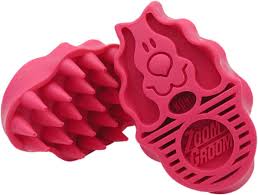 The Zoom Groom
The Zoom Groom
The Zoom Groom removes loose hair like a magnet, and it stimulates capillaries and natural oil production for healthy skin and a healthy coat. It is like giving your dog a massage at the same time.
Can be also used in the bath on a wet coat. There are imitations of The Zoom Groom available but I have found that they don’t work as well as the Zoom Groom is made of a special type of rubber that attracts the loose fur well.
Shedding Blade

The shedding blade is my personal favorite de-shedding tool. It can be held in one-handed or the handle splits in two so you can use two-handed. Also great for dragging excess water off your dog after the bath.
It is important to note that with the steel de-shedding tools like this and the Furminator it is best not to do too much in one session as they can be scratchy and may cause brush burn and aggravate the skin. This is not a problem with the Zoom Groom.
How to brush your dog.
Starting with a slicker brush, part your dog’s fur and brush down and away from the skin. Many people just brush the top of the coat and don’t realize the coat is matted underneath. Always brush in the direction of the coat. Many dogs don’t like to be brushed backward.
Be gentle or you may damage your dog’s coat by pulling and stretching hairs until they tangle and break.
Run your steel comb through the area you have just brushed to check for any tangles. If you do find tangles use your de-matting tool to gently remove the knot.
Repeat the process all over your dog. Your dog is fully brushed when your steel comb will go through without resistance. The short video below demonstrates this simple process.
For double coated dogs you can follow a similar process. First using your slicker brush and then going over with a de-shedding tool and finally running your steel comb through to test and remove any dead undercoat you have missed.
How often should I brush my dog?
The frequency of brushing required for your dog depends on the type of coat.
Non-shedding breeds such as poodles and bichon need to be brushed several times a week if not daily depending on how long the coat is. If they get wet it is a good idea to brush them out once dry as water causes any tangles to tighten and matt easily.
Long-haired breeds need to be brushed weekly and sometime more often if the coat seems particularly tangled.
Short-coated dogs such as Labradors or Dalmatians don’t need to be brushed as frequent, however, if they are shedding a lot it pays to give them a brush with a de-shedding tool.
Short wirey breeds such many of the terriers need a brush over with a slicker and a steel comb run through the coat to remove dead hair in the undercoat.
How to remove knots and matts
There are several simple techniques to remove any knots and matts in your dog’s coat depending on how big the matt is and how tight and close to the skin it is.
Use you slicker brush to locate the knot and gently brush to loosen. Use your de-matting tool or finger to pick the knot apart and finally use you steel comb to remove any tangle remaining.
If it is a tight matt and close to the skin use scissors to cut the top of the matt off. Then pick apart with your fingers or de-matting tool and then your steel comb. Never try to cut under the matt as it is highly likely you will cut your dog. You can also use the point of your scissors to slice through the middle of the knot and then once it is broken up use your de-matting tool and steel comb to finish it off. Always splice away from your dog to avoid injury to them or you.
I use thinning scissors also to break a matt down which doesn’t leave scissor marks and you can’t see where the knot was removed.
If your dog is severely matted over a large area of the coat it is often better to clip them off as even if it is possible to completely de-matt them it would be uncomfortable for them.
Some areas may be better to clip the knot such as under the armpit as the skin is very thin and can tear easy.
Related Posts